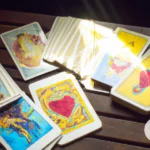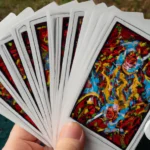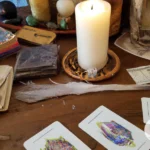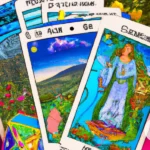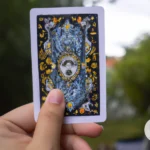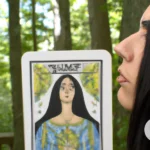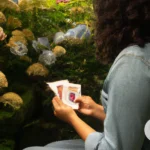Symbolism has always played a significant role in divination tools like Tarot and Oracle cards. Even though they have been around for centuries, they continue to be widely used today. But what do these symbols actually mean? How can we interpret them to gain insight into our lives? In this comparative overview, we will explore the significance of symbols in both tarot and oracle cards. We’ll examine the differences and similarities between the two and delve into the meaning behind the various symbols found in these cards. Let’s begin our journey into the world of divination and unlock the mysteries of symbolism together.
Tarot Cards vs. Oracle Cards
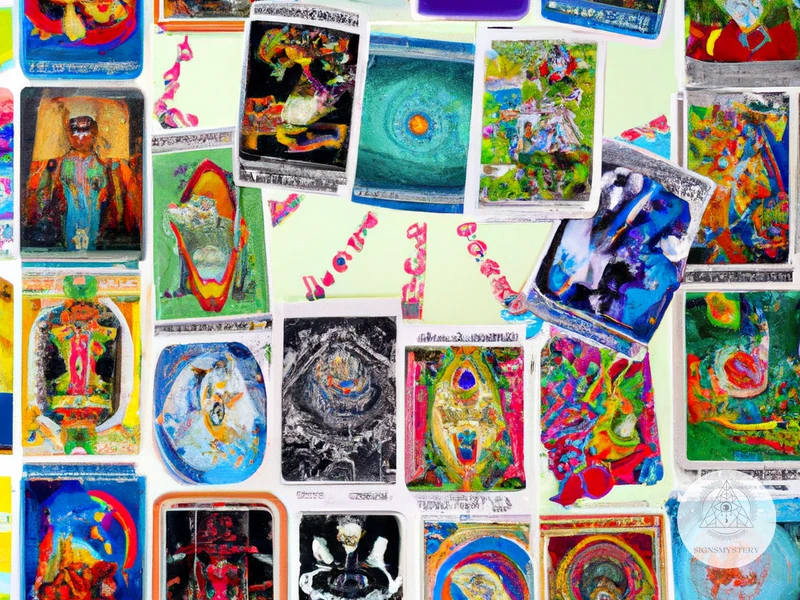
When it comes to divination and gaining insights from the spiritual world, Tarot cards and Oracle cards are two of the most popular tools used by practitioners. Both of these card types are adorned with various symbols and imagery, and they are believed to hold significant meaning that can provide guidance and clarity. However, many people may be perplexed as to what sets these two card types apart, and how their symbolism might differ. Let’s explore the similarities and differences between Tarot cards and Oracle cards and understand what each can offer to your spiritual practice. To dive deeper into the topic, you can also check out our comparative analysis of Major Arcana in Tarot and Oracle cards.
How They Differ in Symbolism
When it comes to symbolism, Tarot cards and Oracle cards differ in several ways. Tarot cards have a structured set of symbols that are consistent across every deck, while oracle cards vary much more widely in their symbolism.
To illustrate this difference further, let’s take a look at the following table:
| Tarot Cards | Oracle Cards |
|---|---|
| Tarot cards follow a consistent symbolism across different decks. | Oracle cards vary widely in the symbols they use. |
| Tarot cards have a specific set of Major and Minor Arcana cards with specific meanings. | Oracle cards can have a variety of different themes with symbols related to that theme. |
| Tarot cards often use more traditional symbolism, such as that from ancient mythology. | Oracle cards can use a variety of symbols, including those from nature, animals, and even modern technology. |
| Tarot cards are often used for divination and self-discovery. | Oracle cards can have a variety of uses, including divination, inspiration, and guidance. |
Tarot cards tend to have a more consistent and structured set of symbols, while oracle cards are known for their diverse and varied symbols. This is because oracle cards can cover a wider range of themes, including animals, nature, and even modern-day objects, while tarot cards generally stick to traditional symbolism. Additionally, tarot cards are often used for divination and self-discovery, while oracle cards can serve a variety of purposes, including guidance and inspiration. It’s important to keep these differences in mind when choosing a card deck to work with, as each type of deck will have its own strengths and limitations.
How They Are Similar in Symbolism
Although Tarot cards and oracle cards have their differences in symbolism, they also share several similarities. One similarity is the use of archetypes, which are universal symbols or images that tap into the collective unconscious. These archetypes can be found in both Tarot and Oracle cards.
Another similarity is the use of numbers. Both Tarot and Oracle cards utilize numbers in their symbolism. Tarot cards have 78 cards, with 22 major arcana cards and 56 minor arcana cards divided into four suits of 14 cards each – Pentacles, Swords, Wands, and Cups. Meanwhile, Oracle cards have a varying number of cards, sometimes grouped into themes or suits, but still utilizing numbers as a form of symbolism.
A third similarity is the use of elemental symbolism. Tarot cards have four suits that correspond with the four elements: Pentacles represent earth, Swords represent air, Wands represent fire, and Cups represent water. Similarly, some Oracle cards incorporate elemental symbolism into their imagery, such as nature-based Oracle decks that use earth, air, fire, and water as symbols.
While Tarot and Oracle cards may have their unique symbolism, they also share similarities in the use of archetypes, numbers, and elemental symbolism. These shared characteristics allow readers to draw connections between the two types of cards and use their knowledge of one to inform their practice with the other.
Understanding the Symbols in Tarot Cards
As we delve into the world of tarot cards, we begin to discern the rich tapestry of symbolism that is weaved into each and every card. Each symbol, color, and image tells a story and carries a deep meaning that can provide insights into our lives and futures. In this section, we will explore the significance of symbols specifically in tarot cards. From the Major Arcana to the Minor Arcana, we will examine how the different cards utilize symbolism to convey their messages. If you’re curious about the differences between Tarot and oracle cards, make sure to check out our comparative analysis.
The Major Arcana
The Major Arcana cards are one of the two categories in Tarot cards. They consist of 22 cards, each representing a different archetype or universal theme. The cards have rich symbolism that represents various aspects of human life, including emotions, spirituality, and personal growth. The Major Arcana cards have a significant impact on a Tarot reading, as they represent major life events and can indicate whether the reading will be positive or challenging.
Here is a list of the Major Arcana cards and their symbolism:
- The Fool: The beginning of a new journey, taking risks, and stepping into the unknown.
- The Magician: Manifestation, power, and creativity. The Magician symbolizes the ability to turn thoughts into reality.
- The High Priestess: Intuition, hidden knowledge, and the subconscious. This card represents trusting our inner voice.
- The Empress: Fertility, nurturing, and creativity. This card represents abundance and growth.
- The Emperor: Authority, structure, and leadership. This card represents stability and order.
- The Hierophant: Tradition, conformity, and orthodoxy. This card represents religion and spirituality.
- The Lovers: Love, harmony, and relationship. This card represents partnership and connection.
- The Chariot: Willpower, determination, and success. This card represents victory and accomplishment.
- Strength: Courage, perseverance, and inner strength. This card represents the power of our mind and spirit.
- The Hermit: Soul-searching, introspection, and solitude. This card represents the need for retreat and reflection.
- Wheel of Fortune: Change, destiny, and karma. This card represents the cyclical nature of life and the need to embrace transformation.
- Justice: Fairness, impartiality, and truth. This card represents balance and responsibility.
- The Hanged Man: Surrender, release, and suspension. This card represents the need to let go and look at things from a different perspective.
- Death: Endings, letting go, and transformation. This card represents change and the natural cycle of life.
- Temperance: Moderation, harmony, and compromise. This card represents balance and healing.
- The Devil: Materialism, temptation, and addiction. This card represents self-imposed limitations and the need to break free from them.
- The Tower: Shock, upheaval, and chaos. This card represents crisis and the need to rebuild and start anew.
- The Star: Hope, inspiration, and faith. This card represents guidance and optimism.
- The Moon: Unconscious, illusion, and intuition. This card represents the unknown and the power of our imagination.
- The Sun: Vitality, clarity, and happiness. This card represents joy and positivity.
- Judgment: Rebirth, renewal, and awakening. This card represents a new beginning and second chances.
- The World: Completion, integration, and wholeness. This card represents accomplishment and fulfillment of goals.
Each Major Arcana card has its own energy and message. Understanding their meanings and interpretations can provide insight into different aspects of our lives and assist us in navigating them. To deepen your understanding of the Major Arcana cards, it can be helpful to explore their connections to the suits and courts in Tarot or examine how they compare to the symbols in Oracle cards.
The Minor Arcana
The Minor Arcana in tarot cards is divided into four suits, each representing a different element and aspect of life. These suits are Wands/Fire, Cups/Water, Swords/Air, and Pentacles/Earth. Each suit has cards numbered ace through ten, as well as four Court Cards: Page, Knight, Queen, and King.
The Wands suit represents creativity, energy, and passion, and is associated with the element of Fire. The Ace of Wands signifies new beginnings and creative potential, while the Ten of Wands represents the end of a journey or burden. The Court Cards in this suit often represent charismatic and ambitious individuals.
The Cups suit is associated with emotions, relationships, and intuition, and is represented by the element of Water. The Ace of Cups symbolizes emotional fulfillment and new connections, while the Ten of Cups represents lasting happiness and fulfillment in relationships. The Court Cards in this suit are often intuitive and empathetic individuals.
The Swords suit represents the mind, communication, and decision-making, and is associated with the element of Air. The Ace of Swords represents new ideas and mental clarity, while the Ten of Swords represents an end to a difficult situation. The Court Cards in this suit often represent analytical and strategic thinkers.
The Pentacles suit symbolizes materialism, practicality, and abundance, and is associated with the element of Earth. The Ace of Pentacles represents new opportunities and financial stability, while the Ten of Pentacles represents ultimate fulfillment and wealth. The Court Cards in this suit often represent reliable and responsible individuals.
Compared to oracle cards, tarot’s Minor Arcana is more structured, with specific meanings assigned to each card based on its suit and number. Oracle cards, on the other hand, may use different systems for their suites, such as using elements or animals. To learn more about the differences between tarot and oracle suits and courts, check out our article on the topic.
Exploring the Symbols in Oracle Cards
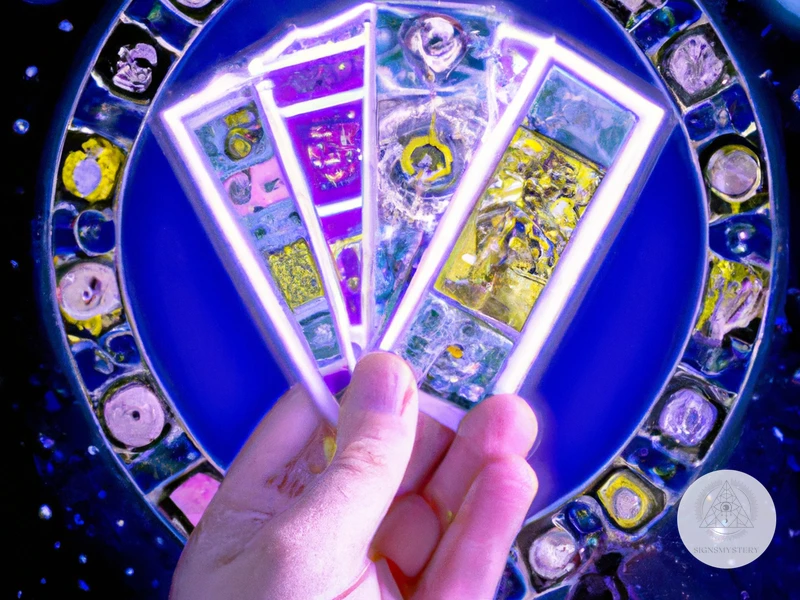
As we delve further into the world of divination, the symbols found in Oracle cards take on a greater significance. The symbols in Oracle cards are just as important as those in Tarot cards, but they often differ in subject matter and level of detail. While Tarot cards tend to focus on archetypal images, Oracle cards can include a wider variety of symbols including nature-based, astrological, and mythological symbols. In this section, we will explore some of the most common types of symbols found in Oracle cards and their meanings. This will help you gain a deeper understanding of the messages contained within these cards, whether you’re an experienced reader or just starting out.
Nature-Based Symbols
Nature-based symbols are commonly found in oracle cards and tarot cards alike. These symbols can represent various aspects of the natural world, from animals to plants to the four elements (earth, air, fire, water). Understanding the meanings behind these symbols can provide insight into the messages being conveyed in the cards.
In oracle cards, nature-based symbols are often used to represent different animals and natural phenomena. Let’s take a look at a few examples in the table below:
| Symbol | Meaning | Oracle Deck Example |
|---|---|---|
| Butterfly | Transformation, change | Butterfly Oracle Cards for Life Changes |
| Owl | Wisdom, intuition | Wisdom of the Oracle Divination Cards |
| Sunflower | Vitality, success | Botanical Inspirations Deck |
| Thunderstorm | Upheaval, change | Mystical Shaman Oracle Cards |
In tarot cards, nature-based symbols can be see in the Minor Arcana cards. Each suit represents an element (Wands = fire, Cups = water, Swords = air, Pentacles = earth) and contains various natural symbols within the cards. For example:
| Tarot Card | Nature-Based Symbols |
|---|---|
| Five of Wands | Crashing waves, turbulent wind |
| Three of Cups | Blossoming flowers, rippling water |
| Ace of Swords | Mountain peak, soaring birds |
| Seven of Pentacles | Lush garden, ripe fruit |
It’s important to note that the meaning of these symbols can vary depending on the context of the reading and the individual interpretations of the reader. Keeping track of these symbols and their meanings in a journal can be helpful for reference.
Nature-based symbols play an important role in both oracle and tarot cards, offering insights into the natural world and our connection to it. Understanding their meanings can provide a deeper understanding of the messages being conveyed in the cards.
Astrological Symbols
Astrological symbols are a common theme in oracle cards. These symbols represent the zodiac signs and planetary bodies that are believed to influence different aspects of our lives. Here are the most common astrological symbols found in oracle cards, along with their meanings:
| Astrological Symbol | Meaning |
|---|---|
| The Sun | Symbolizes vitality, creativity, and self-expression. It can also represent father figures and masculine energy. |
| The Moon | Symbolizes emotions, intuition, and the unconscious mind. It can also represent mother figures and feminine energy. |
| Mercury | Symbolizes communication, learning, and intellect. It can also represent travel and transportation. |
| Venus | Symbolizes love, romance, and beauty. It can also represent pleasure and indulgence. |
| Mars | Symbolizes energy, passion, and aggression. It can also represent conflict and competition. |
| Jupiter | Symbolizes expansion, growth, and opportunity. It can also represent luck and abundance. |
| Saturn | Symbolizes responsibility, discipline, and challenges. It can also represent authority figures and rules. |
| Uranus | Symbolizes change, innovation, and progress. It can also represent unconventional ideas and rebellion. |
| Neptune | Symbolizes spirituality, imagination, and mysticism. It can also represent illusion and confusion. |
| Pluto | Symbolizes transformation, power, and renewal. It can also represent the shadow self and hidden truths. |
Astrological symbols can add depth and complexity to an oracle card reading. When interpreting these symbols, it is important to consider the context of the reading and to trust your intuition. For more information on interpreting symbols in tarot and oracle cards, check out our article on numbers in tarot vs. oracle cards or our article on diversity in tarot vs. oracle cards.
Mythological Symbols
Oracle cards often incorporate symbols from myths and legends to convey messages and meanings. These symbols can be drawn from various mythologies, including Greek, Egyptian, Celtic, and Native American.
Table 1: Examples of Mythological Symbols in Oracle Cards
| Symbol | Mythology | Meaning |
|——–|———–|———|
| Phoenix | Greek | Rebirth and transformation |
| Ankh | Egyptian | Life and vitality |
| Valkyrie | Norse | Protection and guidance |
| Pegasus | Greek | Courage and inspiration |
| Dragon | Chinese | Strength and power |
| Unicorn | Celtic | Purity and innocence |
| Thunderbird | Native American | Freedom and divine power |
These symbols can provide insight into the querent’s current situation and potential paths forward. For example, drawing the Phoenix card may indicate that the querent is going through a period of transformation and renewal. The Ankh symbol can point to issues related to health and vitality, while the Valkyrie card may suggest that the querent needs guidance and protection.
Understanding the stories and meanings behind these symbols can offer a deeper understanding of their significance in oracle card readings. It’s also important to keep in mind that different decks may interpret these symbols in slightly different ways, so it’s always best to consult the guidebook or use your intuition to discern their specific meanings in a given reading.
How to Interpret Symbols in Tarot and Oracle Cards
When it comes to interpreting symbols in tarot and oracle cards, it can be an intimidating process. After all, there are multiple meanings and interpretations that can arise from a single symbol, and deciphering their significance relies heavily on personal connections and intuition. However, the process can become less perplexing by utilizing a few methods and tools that can help guide your interpretation. In this section, we will explore some useful tips on interpreting symbols in tarot and oracle cards, unlocking a deeper understanding of their messages.
Consider the Context
When interpreting symbols in Tarot and Oracle Cards, it is essential to consider the context in which they appear. This means taking into account not only the card’s meaning but also the question being asked and the position of the card in the reading. Here are some things to keep in mind when considering the context:
- Question: What isthe querent asking? The answer to this question will influence the interpretation of the symbol.
Subscribe to Our Newsletter
Sign up to receive the latest news and updates.
- Position: What position does the card appear in the reading? Is it in the past, present, or future position? Is it a blockage, challenge, or advice card? The position will provide insight into the role the symbol plays in the overall reading.
- Surrounding Cards: What other cards are in the spread, and how do they relate to the card in question? The surrounding cards can add layers of meaning to the symbol.
- Card Meaning: What is the traditional meaning of the card? The symbol may take on a slightly different meaning depending on the card it appears on.
Taking all of these factors into account will help you get a more accurate interpretation of the symbol. Keep in mind that symbols can be complex and multi-layered, so it’s important to approach them with openness and curiosity. Ultimately, the interpretation of the symbol will depend on the individual reader and their unique perspective.
Trust Your Intuition
One important aspect of interpreting symbols in tarot and oracle cards is to trust your intuition. While it may be tempting to rely solely on guidebooks or the interpretations of others, your own inner guidance can provide valuable insights and nuances that may not be captured in a book.
Here are some tips for trusting your intuition:
- Clear your mind: Before starting a reading, take a few deep breaths and clear your mind of any distractions or preconceived notions.
- Observe your initial reactions: When viewing a card, pay attention to your initial reactions, images, or emotions that come up for you. These can provide clues to the card’s meaning that are personalized to your unique perspective.
- Don’t overthink: Avoid the tendency to rationalize or overanalyze the symbolism. Instead, allow the impressions and insights to come to you naturally.
- Trust yourself: Remember that you are the expert of your own inner world. Trust that the symbols that resonate with you may hold a deeper meaning than what is written in a guidebook.
By trusting your intuition, you can uncover meaningful and relevant interpretations of the symbols in tarot and oracle cards. This can help you gain a deeper understanding of your inner self and the world around you.
Refer to a Guidebook
Another helpful way to interpret symbols in Tarot and Oracle Cards is by referring to a guidebook. Many Tarot and Oracle decks come with a guidebook that explains the meaning behind each card and its symbols. These guidebooks can offer valuable insight into the intention behind the artwork and the symbolism that the artist has chosen to include.
Here are some tips on how to effectively use a guidebook when interpreting Tarot and Oracle Cards:
- Read thoroughly: Take the time to read the entire section on the card you are trying to interpret. Sometimes, the symbolism of a card can be complex and multi-layered, so it’s important to read all the information available.
- Look for themes: As you read through the guidebook, pay attention to themes that emerge. For example, if you are interpreting a Tarot card from the Major Arcana, you may notice that many of the cards deal with themes of transformation and change.
- Consider the artist: Each artist has their own unique style and approach to Tarot and Oracle Cards. It can be helpful to research the artist to gain a deeper understanding of their perspective and creative vision.
- Keep an open mind: While guidebooks can be a helpful tool, they shouldn’t be seen as the only source for interpretation. It’s important to trust your own intuition and personal experiences when exploring the symbolism of Tarot and Oracle Cards.
Remember, guidebooks are just one tool in your interpretation toolkit. Use them as a starting point for understanding the symbolism within the cards, but don’t be afraid to bring your own unique perspective and insights to the table.
Pay Attention to Repeating Symbols
It is important to pay attention to repeating symbols in both tarot and oracle cards. When a symbol appears more than once in a reading, it can indicate a deeper meaning and significance. One way to keep track of repeating symbols is to create a table and note each symbol and the number of times it appears in the reading. Here is an example of how such a table might look:
| Symbol | Number of Occurrences |
|---|---|
| Wolf | 3 |
| Tree | 2 |
| Moon | 4 |
| Water | 1 |
In this example, the symbols “Wolf” and “Moon” appear multiple times, indicating that they hold special significance in the reading. It is important to consider the context and meaning of each symbol when interpreting their significance in a reading. For example, a repeating symbol of the wolf could represent loyalty, protection, or the importance of finding one’s own path in life. The repeating symbol of the moon could indicate intuition, emotions, or the cyclical nature of life.
By keeping track of repeating symbols in a reading, you can gain a deeper understanding of the messages and themes that the cards are trying to convey. It is important to consider each symbol within the larger context of the reading, and to trust your intuition when interpreting their meaning.
Keep a Symbol Journal
One way to deepen your understanding of symbols in tarot and oracle cards is to keep a symbol journal. In this journal, you can record the symbols that you come across during readings and meditations, and reflect on their possible meanings.
To create a symbol journal, start by obtaining a dedicated notebook or journal. It can be as simple or as decorative as you like. Then, create a page for each symbol that you encounter, and write down the name of the symbol at the top of the page using bold or underline styling.
Next, jot down any immediate impressions that you have of the symbol. For example, you might write down “love” or “protection” if the symbol reminds you of these concepts. You can also write down any personal associations that you have with the symbol, such as experiences or memories that come to mind.
After that, do some research to learn more about the symbol’s traditional meanings and associations. You can consult guidebooks, online resources, or your own intuition. Write down any insights or information that you uncover on the symbol’s page.
Finally, revisit your symbol journal regularly to review what you’ve learned and see if new insights arise. You might notice patterns or connections between symbols that you hadn’t seen before. By keeping a symbol journal, you can deepen your understanding of the rich tapestry of symbolism in tarot and oracle cards, and develop a more nuanced approach to their interpretation.
| Steps to Keep a Symbol Journal: |
|---|
| 1. Obtain a dedicated notebook or journal |
| 2. Create a page for each encountered symbol |
| 3. Write down immediate impressions and personal associations |
| 4. Research symbol’s traditional meanings and associations |
| 5. Write down insights or information uncovered in research |
| 6. Revisit symbol journal regularly to review and gain new insights |
Conclusion
In conclusion, the significance of symbols in tarot and oracle cards cannot be overstated. Both types of cards use symbols to convey meaning and provide deeper insight into our lives. While tarot cards have a more structured set of symbols and meanings, oracle cards draw from a wider range of symbols and can offer more unique interpretations.
When interpreting symbols in these cards, it is important to consider the context, trust your intuition, refer to a guidebook if needed, pay attention to repeating symbols, and keep a symbol journal to track your interpretations over time. With practice and patience, you can develop a deeper understanding of the symbols and their meanings, allowing you to gain greater insights into your own life and the world around you.
Ultimately, engaging with tarot and oracle cards requires an open mind and a willingness to explore the unknown. Whether you are using these cards for personal growth or to connect with spiritual energies, the symbolism within them can guide you on your journey. Remember to approach the cards with humility and respect, and always be open to new insights and perspectives. So, explore the symbols, trust yourself, and enjoy the ride!
Frequently Asked Questions
What is the difference between Tarot Cards and Oracle Cards?
Tarot cards have a structured 78-card deck with specific meanings for each card, while Oracle Cards can have any number of cards with more flexible meanings and themes.
What types of symbols are found in Tarot Cards?
Common Tarot symbols include animals, elements, numbers, and astrological signs.
What is the significance of the Major Arcana in Tarot Cards?
The Major Arcana represents significant life events and personal growth, such as the Fool’s journey from innocence to enlightenment.
What is the significance of the Minor Arcana in Tarot Cards?
The Minor Arcana represents everyday life and daily struggles, and is divided into four suits: Swords, Cups, Wands, and Pentacles.
What types of symbols are found in Oracle Cards?
Oracle Cards can feature a wide variety of symbols, including nature-based symbols like flowers and wildlife, astrological symbols like the moon and stars, and mythological symbols like dragons and unicorns.
How can I interpret the symbols in Tarot and Oracle Cards?
You can interpret symbols by considering the context, trusting your intuition, referring to a guidebook, paying attention to repeating symbols, and keeping a symbol journal.
Can I use Tarot and Oracle Cards interchangeably?
While they share some similarities, Tarot and Oracle Cards have different structures and meanings, so they are best used for their intended purposes.
What is the significance of nature-based symbols in Oracle Cards?
Nature-based symbols can represent growth, change, and harmony with the natural world.
How do I choose a Tarot or Oracle Card deck?
It’s important to choose a deck that resonates with you and your personal beliefs and interests, as well as one with clear and consistent symbolism.
Can I use Tarot and Oracle Cards for divination?
Yes, Tarot and Oracle Cards can be used for divination, but it’s important to approach them with an open mind and healthy dose of skepticism.




